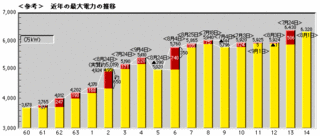Japan Current Events
Because of the tainted pet food fiasco and other issues with foods imported from China last year, China has recently agreed to follow the higher food safety standards of the US in several categories including pet food, fish, low-acid canned goods, and raw materials like wheat gluten.
This makes sense, right? Imported goods should follow the safety standards of the nation they are being brought into. Americans shouldn't have to worry about eating substandard food. Or buying harmful things from other nations. Nobody should.
So why does the US keep insisting that Japan lower its standards and import American beef that isn't acceptable here? In Japan all cows, 100% of them, are tested for BSE (mad cow disease). In America, not even 1% of cows are tested. Even if you want to test all your American cows, you can't. It is illegal.
This really annoys me. How dare the US insist that exporting countries following their standards, yet also insist that importing countries abandon any stricter standards. You can't have it both ways. That is hypocritical.
Barak Obama lost any chance at my vote today when I read he told ranchers that Japan should lower its standards:
"You can't get beef into Japan and Korea, even though, obviously, we have the highest safety standards of anybody," he told a town hall meeting in Watertown, South Dakota. "They don't want to have that competition from U.S. producers."
"Highest safety standards?" Helloooooo? Test all your cows and you can export as much as you like to Japan. "Don't want competition?" No. Don't want disease. Honestly, Mr. Obama, get your facts straight here. You are wrong.
The US really makes my blood boil sometimes (lots of times). Do you know that they force Japan to buy rice it doesn't need? That's another post in itself. Maybe tomorrow.
Foreign Minister Masahiko Komura is considering making Japanese ability a requirement for long-term gaijin. Of course the ministry haven't said what level of proficiency would be needed, who would be required to prove their language levels, or how and when any of this might be implemented.
With my still limited Japanese, this strikes a certain amount of terror in my heart.
But like all of Japan's rules and regulations, it will be approached with a certain amount of flexibility and "spirit of the law" that will be in the hands of each bureaucrat. So がんばりましょう!
Today was 海の日, the "Marine Day" holiday, so Tod & I headed down to Shonan to visit with MJ & Yoshi and enjoy the sea breezes under a cloudy post-typhoon sky. The waves were high and the beach littered with storm trash, but we sat above it all in the sand and played Catch-phrase (thanks again, Ultra Mom) and attempted badminton in the wind.
What we didn't know until later is that while we were en route, there was a huge earthquake in Niigata of the same magnitude (6.8) that destroyed so much of the area in 2004. I tried calling my friends up there, but the phone lines are congested or out of service. I'm confident they must be OK, but I will try again tomorrow until I can get through. Just like everyone else, I guess.
Today also marked the 9th anniversary of our landing in Japan. Hard to believe we were only going to be here for three months and we haven't gone home yet. Time has flown and it hardly seems like nine years could have elapsed so quickly.
Ashes & Snow is a photography and film exhibit in a temporary building at Odaiba. Gregory Colbert has a vision and he's spent years travelling the world capturing interactions between people and animals: monks and elephants; a dancer and a hawk; women and anteaters. Sounds strange? It is, but so quiet and meditatively wonderful, that I cried pretty much the entire two hours I was there.
The photographs are printed huge and hanging in space forming the walls of the corridors that lead to and from the film. They are not labelled, inviting you to actually look at them and figure them out. I took my time with them, and was rewarded with echoing patterns and little surprises hidden in reflections. Although the 60 minute film, which is related to the photographs, feels a little too contrived, it was so beautiful to watch that the moment after I started drifting off and thinking "OK, this is going to be over soon, right?' or "How did he manage to do that?" i was pulled back into the moment by a new and beautiful scene. Personally, I think he could have cut out some of the repetition of similar scenes in different locations, but really, that's a small editorial niggle.
The temporary museum structure is breathtaking, too. It's vast but clever lighting arrangements make it feel cozy. A contradiction built of cargo containers, tenting and cardboard.
In short, you must go to this one. It runs through June 24th in the parking lot near Venus Fort and Decks at Odaiba.
The Mind of Leonardo - Universal Genius at Work is showing at the Tokyo National Museum. I got a free pass from a friend who works at the museum and spent an enjoyable hour and a half exploring.
The first part of the exhibit is a single painting - the Annunciation, the first painting completed by Da Vinci after his apprenticeship. He was in his 20s. It's a lovely painting, more beautiful close up than far away, but you don't get to spend too much time with it as you and everyone else shuffle past in a slow queue. But getting up close is totally worth the line, though I was there on a day when it wasn't too busy. I suspect that on a weekend, the wait might be intolerable.
The second part of the exhibit is in another building entirely and it tries to take a holistic view of Da Vinci's thinking and philosophy. Although he studies and worked in many disciplines - motion, anatomy, painting - he didn't think of them as different things. They were all interconnected. That didn't seem like a major revelation to me, but then I dabble in different things and I know they for me they are interconnected, so why not for DaVinci, too?
I particularly enjoyed looking at some of the Codex that was on display. It reinforces my idea that you should keep notebooks and journals and record your ideas in them. His were greatly interesting and surprisingly not beautiful works of art, but working sketches and notes. They looked very little different from things I've seen in my friends' Moleskines.
The exhibit included were numerous video explanations of things - simulations of how his inventions would have worked and his ideas on anatomical geometry were quite illuminating and entertaining.
If you're interested in a well-presented multi-disciplinary exhibit, this one is for you. Runs through June 17th at the Tokyo National Museum in Ueno.

Masterpieces of the State Russian Museum from Late 18th Century to Early 20th Century (what a title!) may the the summer sleeper of museum exhibits. I went to the opening yesterday (courtesy of my friend, again!) not quite sure what to expect. I find that the Tokyo Metropolitan Art Museum generally bites - its rental galleries are often full of art club exhibitions.
But this exhibit was good. Well-documented and organised, the exhibition takes you from classical paintings in the time of Catherine II through later portraiture of "regular people" into the dark depressing times of poverty and Dostoevsky and back into the light with bold colors of the early 20th century.
There are heroic ocean storms, humorous insights into village life (Hen Party was a favorite), and heart-string tuggers of ragged beggars. If you pay attention, you get an overview not only of the changing style of art, but the changing lives of Russians during this period.
And at the end of the gallery walk, you'll find a shop that sells Russian breads made in Yokohama. Needless to say, I bought some. How can I pass up bread?
This show runs through July 8th at the Tokyo Metropolitan Art Museum, Ueno. There's a theremin concert on May 12th. Maybe I'll see you there?
Saturday began the campaign period for local elections throughout Japan. The Bunkyo-ku council elections will be held next Sunday. There are 34 seats and 45 people running according to the big poster-covered signboard down by the station.
Tod & I stopped to read all the campaign posters. They were interesting. Lots of raised fists (a symbolic "I'm trying hard" pose), many smiling faces, one guy shooting hoops and another in his karate gear. Most were vertical posters, but 5 or 6 renegades designed theirs in landscape orientation. Colors are similar to American campaign posters - strong shades of blue, yellow, red and green. One was orange. In addition to party logos, some candidates have their own personal logos, especially the 13 women running: a red tomato, a four leaf clover, a shrimp. Some candidates listed their ages: 30 years old, 25 years old. One claimed 'I have been working for my community since I was a baby."
Each and every one of the candidates seems to have a minivan fitted out with loudspeakers. They are driving around town announcing their candidates' name and asking people to vote. From where I sit, I can hear overlapping echoes of competing trucks and an occasional direct hit as one cruises up our street.
Just around the corner from us an incumbent candidate, Shiraishi Hideyuki, has taken over a derelict shop as his campaign headquarters. When I walked past at lunchtime, he was standing under his awning, looking youthfully political in a suit and a white sash with his name and campaign slogan hand lettered on it. He bowed politely to a crowd of older women huddled under umbrellas in the rain. He said something and they giggled like schoolgirls.
Shiraishi-san is a member of Shinsei Club, a political faction. Of our 34 current councilors, 9 are affiliated with Shinsei Club. I can't find out much of anything about it, except that it seems to be quite popular among city-level officials across the country.
I like the diversity of political views in our town. Bunkyo-ku currently has 6 Communist council members, 5 members of Japan's ruling party, the LDP, six Komei affiliates, three in Shimin, and two independents. You can take a peek at their pictures and profiles on the Bunkyo-ku website.
Since I can't vote, I'm going to grab my earplugs and try to get some work done. Good luck to everyone who is running.
"The number of women aged between 15 and 50 is fixed," Japan's Health Minister, Hakuo Yanagisawa (71) said in a speech to LDP party members earlier this week. "Because the number of birth-giving machines and devices is fixed, all we can do is ask them to do their best per head … although it may not be so appropriate to call them machines."
Did Yanagisawa think he was being clever? Did he believe that calling women birth-giving machines was going to encourage them to reproduce? His government profile says he is married, but mentions no children. He ought have consulted with Mrs. Yanagisawa before giving that speech.
Prime Minister Abe chastised him and told him to "be more careful" in the future. I think someone with such a disregard for women really ought not be Minister of Health and Labor at all. Mr. Prime Minister, if you really want the birth rate to increase, chuck out Yanagisawa, and bring in someone who won't offend the birth-giving machines.
Geesh.
For the 1964 Olympics, Tokyo reinvented itself to accommodate the needs of a world-class sporting event. The Shinkansen was completed before the opening ceremony; a network of elevated highways sprung up over Tokyo's rivers; a neighborhood was razed to build a stadium and park. The Tokyo we know today was shaped by the needs of the Olympics.
And Tokyo is redesigning itself again, partly in anticipation of hosting the 2016 Olympics (the location will be decided in October 2009, but the city is hopeful) and partly to fill the needs of this still-growing city.
On the 22nd, the Tokyo government unveiled its 10 year plan for Tokyo. It's a huge and detailed document in Japanese, well worth perusing. Here's my brief summary in English:
- Reviving Tokyo's Beauty by Wrapping it in Water and Greenery
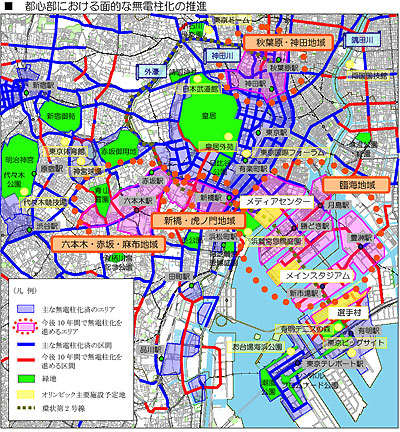
Blue indicates areas with underground power lines; red/pink shows planned burials. The yellow areas are possible Olympic sites.
Much of this plan involves building park areas along the Arakawa and Tama rivers (which weren't covered by highways in 1964). Plans also include burying power lines and creating more bright and open spaces in the city.- Refreshing Tokyo with Three Ring Roads
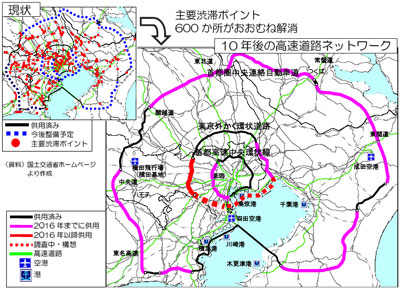
Ring road plans. The pink roads will be completed by 2016. In the inset, the red dots show current congestion points.
Ringing Tokyo will improve traffic to the airports and ports and connect the outlying areas, including the "Tama Silicon Valley," to one another more effectively. Also in the plans are reductions to CO2 emissions and high tech safety controls on highways.- Reducing the World's Environmental Burden
- Tokyo plans to aggressively reduce CO2 levels through use of traffic management and biodiesel public transportation, bringing levels to 25% less than the 2000 measurements. They will build advanced water purification plants along the Tone River to produce 100% of Tokyo's water and they will create new recycling systems and work with private sector recycling businesses.
- Boosting Confidence with Disaster Preparedness
-
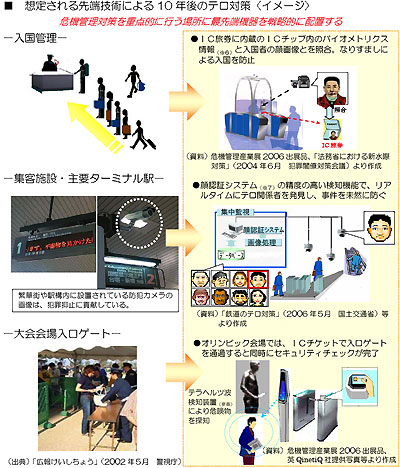
Three terrorism prevention techniques: biometrics at immigration, facial recognition in train stations; IC chipped tickets at event venues
The main goal is to improve not only earthquake safety measures in new construction, but to build flood control and more thorough disaster prevention plans. For instance, along emergency evacuation routes, new hospitals and public works building will be erected. Terrorism will be combated with the latest technology (yes, this is as lame as I make it sound). - Creating a Model City for an Aging Society
- Japan is about to experience a surge in elderly as the post-war babies reach 60. Tokyo has noted that "the elderly have renewed the 'elderly people' image by actively volunteering in the community" and this is something they want to encourage with support of volunteerism. Advanced health care, including robotics and IT networks, and supporting aging foreign residents is also in the plan.
- Establishing Tokyo as a City of Charm and an Industrial Power
- Tokyo will trade on Japan's pop culture and advertise more widely for foreign visitors, making improvements to areas visitors frequent. This section has many comparisons to culture programs in other Olympic cities.
- Creating a Can-do Spirit in Everyone
- This is a soft goal, revolving mainly around encouraging students to seek higher education and for everyone to participate in NGOs and volunteer activities.
- Sharing the Dream of Sports with the Next Generation
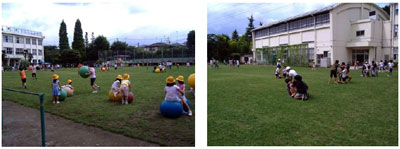
The future of Japanese sports.
Japan's kids are getting fatter and less athletic. Where will the future Olympians come from? Tokyo will support youth sports clubs and establish a network of volunteers to train kids in sports.

Maturing rice in Kanagawa
The rice harvest begins September 10th, and I'm off to Matsudai to help for a few days.
Signs are pointing towards a North Korean missile test in the near future, perhaps as soon as today according to some reports. Dear Leader lobbed the previous one (in 1998) over Japan and into the ocean, so be prepared to duck and cover just in case it goes awry.
Tomorrow is the "official" day to start wearing summer uniforms and summery clothing like white dresses and linen suits. So keep your eyes open today, and note that the people in uniform in your neighborhood (schoolkids, policemen, railway & subway folks, construction workers) may all be dressed differently tomorrow.
June 1 kicks off the period for CoolBiz 2006, so businessmen are dressing for the summer, too. To conserve energy, the Ministry of the Environment is asking companies to keep their offices at 28°C (82°F), and workers are requested to dress appropriately - short sleeves, no ties, lightweight suits. CoolBiz style.
The department stores love this, setting up displays of ways to look corporate without a necktie, and the government sponsored a fashion event in Omotesando Hills today. But it's a hard sell. In Wakayama-ken, where the weather is warmer, the prefectural government started CoolBiz last week. According to a newspaper report only 80 of 2300 employees turned up without ties.
So get out your white shoes, press up all that lovely linen and get ready for summer dressing. It's supposed to be sunny and 28° in Tokyo tomorrow.
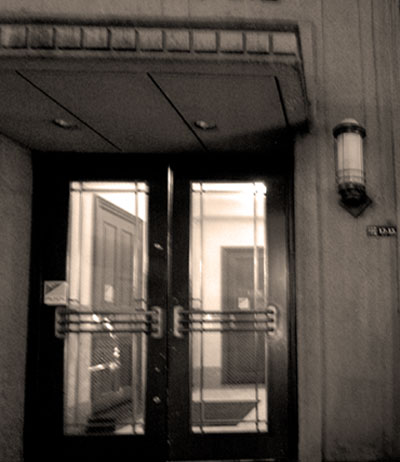
Moriokia Shoten. Inoue Bldg 2 #305, Nihonbashi-Kayabacho 2-17-13, Chuo-ku.
This evening I attended an opening party. It wasn't at a gallery or a museum. It was the opening of an exclusive word-of-mouth bookstore on the third floor of a delightfully vintage building overlooking Kamajima-gawa in Kayabacho.
Morioka Shoten specialises in early 20th century design, photography, art & photography books - mainly from Europe. Morioka-san, a young man who learned the trade at one of the venerable Jimbocho booksellers, has a small but impressive collection of books by Czech designer Josef Čapek & his brother Karl as well as a wide variety of other interesting books.
I'm looking forward to going back on an evening when it isn't so crowded and hot to spend more time perusing the books.
The Japanese government passed a law today that will affect me, most of my friends, and over 6 million other gaijin.
Foreigners visiting Japan will be photographed and fingerprinted on entry, including those living here, who will be photographed and fingerprinted upon any re-entry to Japan.
Of course, it's done in the name of anti-terrorism, safety and national security. Since the US has been doing this same thing to its foreign visitors since 2004, Japan was bound to follow. Wasn't it?
No date has been set to begin this procedure. Perhaps some of the groups that have protested can create a diversion before the government can pass the budget and schedule portions of the legislation. But that seems doubtful. This snippet from the Asahi Shimbun does not promise much good:
Meanwhile, Gayle S. Nix, a senior official at the U.S. firm Accenture, said little information is available on known terrorists and that border-control data ought to be shared among nations in the future.She said resistance to governments holding personal data such as fingerprints will likely ease over time.
Accenture also developed the fingerprint data-management system that the U.S. government adopted in 2004 to track all foreign nationals entering the United States.
Accenture won a bid from Japan last fall to develop an experimental immigration tracking system that includes integrated-circuit chip embedded cards capable of storing the fingerprint data of the holder.
The IC-card system will be used once the fingerprinting requirement legislation is passed.
Won't be long before we're all so comfy with governments "holding personal data", that we'll eagerly line up for our free, legislated RFID tags so our every move can processed to prove we're Good Citizens.
Stop this world! Let me off. What to do? What to do? Get off the grid. Start my own nation. Stop moving about in the world... I don't know how.
On January 16th, I wrote about an upcoming trial of anti-terrorism facial recognition at Kasumigaseki station in central Tokyo.
The testing begins on Monday, May 1 and runs for nearly three weeks, until Friday May 19. According to an article off the Japan Economic Newswire:
The Institution for Transport Policy Studies will conduct the experiment for one hour from 2 p.m. every weekday from May 1-19 at a designated ticket gate at Kasumigaseki Station, noting that the test will involve only selected staff and no private passengers.The system is designed to issue an alert if the video monitor detects a person with facial features matching those of a person on a specified list, such as a list of criminal suspects compiled by the police or of condominium residents for checking building entrants, according to NTT Communications.
The system analyses the position of the nose and eyes as well as features of the skin from a video capture of the face, according to NTT Communications.
Technically, it can check one person against a list of 10,000 people per second, the Tokyo-based company said, adding that there is still room for enhancing the system's accuracy before the company releases it onto the market possibly next year.
I doubt they're going to get 3,600 (1 person/sec * 60 sec/min * 60 min/hour) employees together for an hour every day during the test, so they will run a limited test on a powerful system. What's the point? Couldn't they have done that in the lab?
This system offers a false sense of security and not much more. Terrorists are not going to be stopped by a facial recognition system, they'll simply avoid it or work around it by using unsuspected terrorists, plastic surgery, or taxis. If I can think of that, how hard can it be for someone determined to be bad to come up with a better plan?
I also believe that plain old security cameras are a bad way to secure something in the moment, even though they provide handy evidence after the fact. Did all the cameras in London stop the terrorist bombings last July? No. They caught the action on the day and even filmed a dry run of the event more than a week in advance, but nobody noticed and it didn't stop the bombings from happening.
Anti-terrorist measures need a little more thought.
My Turning Point exam wasn't nearly as dreadful as I feared.
When I arrived at 9, there were already 22 people before me, mainly women from their mid-forties to mid-fifties I'd guess, judging from wrinkles and greyness. I saw one much older lady, but I think she was a doctor. Shortly after I arrived, a tall and swarthy man came in, so I wasn't the only foreigner there.
I didn't wait long before the first test - the barium x-ray. I'm glad it was first because I was nervous. MJ projectile vomited when she had to do it. Tod had one last year and said it was difficult and nasty. But I didn't have any trouble with the fizzy stuff or the thick barium shake they made me drink. It went right down and stayed where it belonged. I didn't even feel like burping.
The man running the machine had a patter that never stopped and alternated, rapid fire, between descriptions of what he was doing, "I'm turning the table a little to the side now", and orders for me, "I want you to turn a little to the side now." Unfortunately the distinction was sometimes lost on me and I moved when I shouldn't or turned the wrong way. He was frustrated but we flew through it only a little more slowly than other subjects.
The rest of the examination was a breeze: height & weight, urine sample, medical history, consultation with the doctor - who did nothing but wield a stethoscope - then off for an electrogardiogram, blood draw, retinal photography and a chest xray.
I was out of there in 70 minutes.
Now for the important part...what did I wear and who did I meet during my roujin debut? I chose an ensemble that expressed my casual attitude about the whole affair (yes, yes, roll your eyes): a faded rusty plaid home-made skirt, an embroidered purple t-shirt, a brown hooded sweatshirt, and brown clogs. Despite my sartorial elegance, I didn't really meet anyone. The staff were friendly and pleasant but busy. Okada-san was always before me in line. We exchanged some small smiles of encouragement, but didn't speak a word. Neither did anyone else.
I guess I'll have to find my old-lady social circle elsewhere.
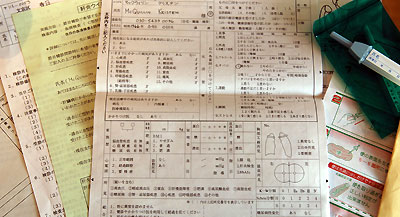
Looming on my desk...
Tomorrow is my roujin debut - the Turning Point Physical Examination I wrote about last month. This could be as important for my social life in old age as it is for young mothers taking their babies to the playground for the first time. I wonder what I should wear?
The ku sent me a big manila envelope stuffed things to read, fill out, and bring with me. A medical history. A permission slip for the barium x-ray. A questionnaire about my Hepatitis C risk factors. And the "ben no torikata" - a do-it-yourself stool sampling kit.
I figured out how to use it from the pictures and simple instructions in the accompanying pamphlet. The joys of functional semi-illiteracy.
The medical history is another matter. I know that one question asks "Do you have any of the following conditions?" but except for high blood pressure I have no idea what the conditions are. One of the kanji looks like kushiage (skewered foods) over heart. What the hell is that??
I'll just answer "no" on that one and hope for the best.
Maybe as the only gaijin in the room (I can pretty safely assume), I will meet all sorts of wonderful old ladies like me. On the other hand, we're all likely to be nervous, stressed and disinclined to chitchat.
I'll report in tomorrow. For now I must fill in forms and plan my outfit.
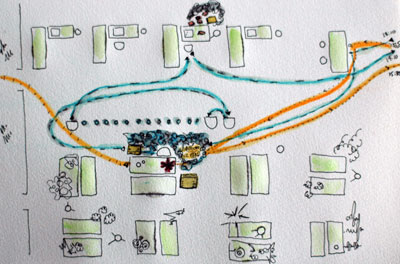
My path(s) through the tax office
Tax day in Japan is March 15th. As I had a question about my return, I bundled up all my bits of paper and walked down to the tax office after lunch today.
It's a busy place this time of year. There are forty seats at desks kittted out with pens, calculators, staplers, carbon paper and extra forms. 70% of the tables were full of harried housewives and small business owners. Another section of the large room is for consultations. I was directed there with about a half dozen other folks.
My question was answered ten minutes after I arrived, and to my surprise, I was told to get in line to use the touch panel system to fill in and print out my forms.
Fortunately there was a nice young man there to help me, because the kanji for tax-related items are quite over my head. He told me which buttons to press and where to fill in various numbers. There was some confusion about my income slips, as two clients didn't send me any, but two did. He told me what to do, and I did it.
I was out of there with a completed and signed return 59 minutes after I walked in to ask my question. Hooray. Then I got home and actually looked at the numbers on the form. Uh-oh. It showed that I should be getting a 988,000 yen refund. That's way too much. A quick calculation returned a more reasonable amount.
I turned right around and returned to the tax office. 25 minutes later, after my mistakes had been taken into the mysterious back room and corrected without my confused meddling, I was on my way with a corrected filing and still anticipating a refund.
To attempt to combat terrorism, Tokyo will install a facial recognition system at Kasumigaseki station, the subway stop nearest the seat of government.
The software, developed by NTT Communications was the hit of last week's Ministerial Conference on International Transport Security. The system can scan faces in just a few seconds and compare them to a database of known suspects. If someone matches, an alarm goes off. Starting in March, every passenger at Kasumigaseki will be photographed, scanned and compared.
This is a stupid waste of time and an invasion of privacy for citizens and visitors.
With half a second's thought if I were a terrorist, I'd use people not suspected - single-serving terrorists - or I'd go blow up locations other than stations. Of course, I suppose just getting around Tokyo without the trains and subways would be an inconvenience, but there are always taxis, rental cars and Shank's pony.
Face recognition is an interesting technology. At My Heritage is a slightly less rude use; you can upload your picture (or anyone's) and during their beta trial see which celebrities you look like. The idea is to develop a database for geneology but it's really rather lame. If you wear glasses, it finds other people wearing similar glasses. If your head is tilted or turned, most of the matches also have tilted or turned heads.
The results from my tests with this photo and this one, indicate I look like Anna Kournikova, Helen Clark, Scarlett Johansson, and Dustin Hoffman. Hmmmm.
I hope the Tokyo trials of the terrorist facial recognition system are more precise.
As reported by Kyodo News (via Japan Today), Japanese men will be buying their partners better gifts this year. They expect to spend, on average, 23,353 yen (about $195) which is 5,596 yen more than last year's present budget.
Women are also planning to spend more. Though that article indicated women were cheaper, becasue they had only added 3,959 yen to their Christmas budget for a total of 17,008 yen ($142), the ratio is just about the same--a 23% increase to the men's 24% increase.
Armed with the information from this report, I'll bet that the department stores have set their pricing accordingly. Sure enough, the first item on Takashimaya's gift list is a 23,000 yen stew pot, followed up by a 263,000 yen crystal chess set, so there may be some wishful thinking over there at the high end of the department store world.
RFID (radio frequency identification) tags are used by warehousing and large retailers to track their stock; the tags are programmed with all kinds of information and identify themselves automatically to any tag reader in the vicinity.
RFID is also used for livestock tagging and in corporate ID badges. In Mexico, the attorney general's lawyers have had RFID tags implanted so they can be tracked in case of kidnappings.
And now Rikkyo Primary School in Tokyo has jumped on the RFID bandwagon in the interest of school security. From April next year, students will have RFID tags pinned to them to monitor their entry and exit from the building. Although it seems benign on one level, don't you think it's a little bit too Big Brother? And will it extend from the doorway to a more thorough monitoring?
"Where's little Ko-chan?" teacher asks.
"In the toilet. Stall three. Been there for....2 minutes 46 seconds," replies the school monitor.
Will these children, along with the countless adults who have RFID implanted or tucked into their wallet, get so used to being tracked that they won't consider it an invasion of privacy?
Sorry, but I'm not going there. no RFID for me, thank you very much.
Not long ago, a 6th grade girl in Sasebo, Japan, killed her classmate in a rather gruesome way at school. Investigators discovered the girls had once been friends and things had gone sour. The victim had written some unkind things about the girl on a website. The murderess (so sad to think of an 11 year old that way, but she is...) also had a website where she posted poetry and other writing expressing her unhappiness and problems.
Today a survey company, Interactive Marketing Interface, announced that 69% of sixth- and seventh-grade female students have their own websites. Do you think that websites will be tied to school violence like video games were after Columbine?
![]() Let's Make Ume Shu 4'38" (28.7 MB MP4)
Let's Make Ume Shu 4'38" (28.7 MB MP4)
 ...starring Tracey Northcott as the barkeep...
...starring Tracey Northcott as the barkeep...
As promised, here's a how to video with everything you need to know to make ume shu (Japanese plum wine). Learn how to choose plums, wash and dry them, sterilse the bottles, layer the fruit with sugar and fill. It's surprisingly easy.
For your shopping and kitchen convenience, here's a recipe to print out.
Ume Shu
1 kg green ume (Japanese plums)
1 kg rock sugar
1.8 liters white liquor (35% alcohol)
Sterilise a 4 liter glass jar by filling it with boiling water, rinsing and drying carefully. Wash the ume, culling any fruit with bruises or broken skins. Dry the ume and remove the waxy bit in the stem end. Dry the fruit again. Layer ume and sugar in the jar, pour in the liquor. Seal tightly. Upend theh jar once a month until the sugar is completely dissolved. The ume shu is drinkable after 6 months, and fully mature at the end of a year.
TOKYO (Kyodo News) -- The government decided Friday to sign a pact to link Asia by highway in a signing ceremony next Monday in Shanghai, government officials said Friday.
Signatories to the U.N. pact will be required to improve their highways to meet the criteria of the 140,000-kilometer Asian Highway network, which is to link 32 nations to one another and to Europe.
But Japan is an island nation, as we are often reminded. Maybe there's an Asian Highway ferry between S. Korea and here...or plans for a terribly long bridge.
I think the Japan highway must be akin to Hawaii's interstate highways.
Having been entirely too happy and carefree lately, I've compiled a list of things I could be worrying about in Tokyo:
Food safety, specifically avian flu
TAMBA, Japan (AP) - Men in white protective suits, masks and hoods moved along the hillside above a chicken farm, spraying disinfectant and throwing lime into a huge ditch filled with thousands of dead birds.
This mountain-ringed town in western Japan is the epicenter in the country's mounting struggle with avian flu, which has compounded worries about the food supply and provoked a scare over the possible spread of the disease to humans.
Those fears have expanded in recent days with the discovery of five wild crows infected with the virus - raising the threat that the freely roaming birds could trigger an uncontrollable spread of the disease.
"That's really worrying," Kaoru Iwamoto, a 55-year-old housewife, said just a few blocks away from a farm being disinfected. "You can control where the chickens go, but crows fly all over the place."
The avian flu hit Japan in January for the first time since the mid-1920s. It has infected chickens at three farms and led to the deaths or extermination of more than 300,000 birds.
So far, Japan has been lucky with no cases of human transmission. The disease has spread to people in Thailand and Vietnam, killing 22 and prompting the cull of about 100 million chickens across Asia.
Terror attacks in Tokyo by al Qaeda or Iraqi operatives
TOKYO (AP) -- Japan added police at railway stations in Tokyo and vowed to stand firm on Iraq after an Islamic militant group reportedly said Japan could be targeted by terrorists.
Japan's conservative government, a firm supporter of the U.S.-led invasion of Iraq, has insisted the deadly bombings that killed 202 people in Madrid last week would not change its backing for Washington.
A London-based Arabic newspaper on Thursday published a message attributed to the Brigade of Abu Hafs al-Masri warning that its next targets could be Japan, Italy, Britain or Australia. The group has claimed responsibility for the Madrid bombings.
Being anonymously reported as a suspicious foreigner
TOKYO � The Justice Ministry on Thursday decided to review its controversial online service that allows people to anonymously submit information via email about suspected illegal aliens to a web site run by the Immigration Bureau after drawing fire from groups supporting foreign nationals living in Japan.
The service, which began Feb 16, allows people to submit information on the identity, address or workplace of suspected illegal aliens. Critics say the service constitutes racial discrimination but the Justice Ministry says it has reminded users that it will not tolerate any attempts to slander foreigners. (Kyodo News)
That long-overdue, city-flattening earthquake
This threat hangs over all our heads, all the time. The city is 10 years overdue on its "70 year cycle" of major quakes. And as far as I've noticed, we haven't even had a moderate one in months.
I tried to come up with a list of ten things to worry about, but I could only think of four. I think that's cause to celebrate...
It seems that two apartments in our neighborhood were robbed of about $1.5 million dollars of Edo-era gold coins, precious metals and cash. Was it in our building...?
Tod saw a film crew outside our mansion last night, one camera on a tripod pointing towards the front door and another panning across the building. This morning my friend Junko sent a mail asking after us, "I watched the news of a robbery in Bunkyo-ku last night and the apartment seemed to be where you live."
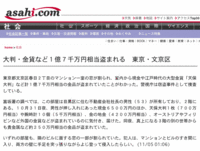 And those two clues sent me off in search of news of the robbery. I found an article at Asahi.com in Japanese that seems to point in the right direction. You can click the image for a larger version or read on for a rough translation.
And those two clues sent me off in search of news of the robbery. I found an article at Asahi.com in Japanese that seems to point in the right direction. You can click the image for a larger version or read on for a rough translation.
I printed the article and took it downstairs to the front desk to ask if this happened in our building. The blue-jacketed gentlemen who watch over the doors were very interested in the article, but they didn't say it took place here. So I guess the robbery happened to some unlucky neighbor and not to the guy down the hall.
Here's what the newspaper wrote (more or less):
"170 million yen in Edo-era gold coins and other valuables were stolen from an apartment in Kasuga 2-chome, Bunkyo-ku Tokyo. Police are investigating.
"The Tomizaka Investigative Department stated that the 2nd floor apartment is owned by the 53 year old president of a Meguro real estate agency. On 10/31, he discovered that 65 million yen in cash, one Tenpo coin worth 7 million yen, 10 watches with a total value of 50 million yen and 42 million yen in gold as well as some foreign gold coins had been taken from his closet. The apartment directly above on the 3rd floor was also robbed of approximately 2.5 million yen in cash and precious metals.
"Police believe that the thief gained access to the apartment by using the building next door for support as he scaled the space between them and broke the window of the apartments." Asahi Shimbun 11/05
On Monday during the 21-nation Asia-Pacific Economic Cooperation conference in Bangkok as leaders debated the fate of nuclear weapons on the Korean peninsula, North Korea shot a test missile into the Sea of Japan. It was a surface to ship missile, apparently part of an annual military exercise, and came nowhere near Japan.
On Tuesday there was a report on NHK, based on US intelligence, of another test firing. You have to wonder how well defended we are here when you read a quote like this from the Defense Agency a couple of hours after the missile was launched, "We are aware of unconfirmed information of that nature. We are now trying to confirm it."
South Korea says there was no second missile, though everyone agrees the DPRK did fire one on Monday. I wonder what the truth is here?
Some reports on the subject:
Al Jazeerah - North Korea had right to test-fire missile: Putin
MSNBC - S.Korea says no evidence of 2nd North missile test
Tribnet - orth Korea rejects U.S. offer as 'laughing matter'
The Toronto Star - North Korea tests anti-ship missile as leaders meet
Get yourself to Shinagawa station this week for an unusual intersection of computing and trains.
Google Japan is holding an event at the new Shinagawa shinkansen station until Friday. Go to the Virgin Cafe and take a quiz; if you get the correct answer, you'll win a Google prize. Everyone gets a Google keitai strap.
Now if only you could Google while on the shinkansen...then I'd pack my laptop for our holiday for sure.
The electricity crunch that we were warned about earlier this year hasn't come to pass yet.
Tepco managed to get enough of its reactors back online to cover the city's power consumption, and their collective corporate prayer for a cool summer was certainly answered.
Oddly, though, this summer's power consumption is nearly as high as last year.
This graph shows power use from 1986 (Showa 60) to 2003 (Heisei 14), noting the peak date of power use and the kilowatt hours/10,000. Our current peak was on August 1st. It was higher than everything except last year's all-time peak.
Maybe Tepco's denki yoho (electricity forecast) backfired. Everyday between 11:30 and noon, every radio and TV station announces how much power is available and what the expected peak is. Every time I've checked, the peak has always been well within the available power. I suppose that might make people care less.
The denki yoho is online, too.
Today's Forecast: http://www.tepco.co.jp/setsuden/corp-com/forecast/index-j.html
Today's Graph: http://www.tepco.co.jp/setsuden/corp-com/forecast/demand-j.html
In the news is the story of four 11 and 12 year old girls who were held captive in Akasaka from Sunday to Thursday last week.
I'm not sure whether the true substance of the story is about poor parenting, bad police work, the naivete of little girls, or whether it's just about a social deviant.
Kotaro Yoshisato, a 29 year old man from from Saitama just west of Tokyo, lured the girls to his condo in the city on the pretense of discussing part-time jobs at his fictitious shop, Petit Angel. In reality, he was looking for girls for his prostitution business. For the past few years, he's paid high school girls as talent scouts to find new, youthful recruits.
He'd met one of the four 6th graders previously and persuaded her to do "part time work" for him and offered her a bonus if she would bring her friends, too. When they all met him again last Sunday, he handcuffed the four to heavy objects, blindfolded them, then bound them hand and feet. On Wednesday night, he committed suicide by poisoning himself with carbon monoxide from a charcoal stove.
One of the girls escaped from her handcuffs on Thursday and went for help. The four sets of parents, all from a Tokyo suburb called Inagi, were very relieved to have their daughters home unscathed but you have to wonder why they let their the girls go into Shibuya unaccompanied.
On Friday, 3500 police officers and social welfare workers spent the day in the area around Shibuya station, reminding young people of the dangers of talking to strangers. According to Kyodo News, they talked to about 1500 kids--2/3 of them boys.
To add to the drama, Kotaro Yoshisato was investigated a few years ago on suspicion of selling illegal pornographic tapes featuring young women. But despite the evidence of sales flyers, a client list and 1000 video tapes, the investigation was dropped.
On June 19th, five students from three of Japan's prestigious universities were arrested for gang raping a woman after getting her drunk at a bar.
Apparently these five and others had a party promotion business/student society with 20 members. Gang rape was one of their sidelines. There's a story in the Mainichi with details.
Last Thursday during a public debate on youth crime and the declining birth rate in Japan, a 57 year old Diet member, Seiichi Ota, said that the declining child population is due to Japanese men being afraid to commit to marriage. When asked by the moderator if that meant the university gang rapists did it because they lacked the courage to propose, Ota replied,
"Gang rape shows the people who do it are still virile, and that is okay. I think that might make them close to normal. I know I'll get in trouble for saying that, though."
Naturally, he did get into trouble. There was outrage from his party, the Prime Minister, and a lot of women legislators. He apologised publicly, so all will be forgiven soon and I'll bet he gets reelected.
50 members of a cult group have been driving their dying leader around the countryside of Japan for the last three years, looking for a place that is free of electromagnetic waves. The Panawave Laboratory members say that their cancer-ridden leader, Yuko Chino, 69, feels worse in the presence of EM radiation.
They stop along country roads and break out their supplies--meters and meters of white fabric, which they use to drape trees, guardrails and the vans they drive. Apparently, white reflects the waves. Everyone wears white and they use mirroed shields to hold back the police who come to move them off the public thoroughfares.
Harmless kooks, more or less. Except that they are also doomsday cultists. Panawave believes that the world will end this Friday, when an EM surge realigns Earth's axis, or Planet X appears on the horizon, or some such drivel depending on which account you read.
Here are a few for you to sample:
Profile of cult leader Yuko Chino (Daily Mainichi),
Photo essay on the Panawave cult(Daily Mainichi),
An overview of the recent Panawave attention (The Independent),
City council gives cult a year to close shop even though the world ends in two days (via Japan Today),
and the Panawave Laboratory home page (in Japanese).
I have plans for Saturday, so the Earth had better not end on Friday!
Looks like it's time to buy a UPS or two for the office.
Kyodo News - The Tokyo metropolitan area may face serious power shortages as early as the end of June due to the shutdown of nuclear reactors operated by Tokyo Electric Power Co (TEPCO) over a defect cover-up scandal, TEPCO officials said Thursday.
Concerns about a possible power outage in the Kanto region centering on Tokyo have grown since TEPCO shut down all of its 17 reactors for safety checks on April 15 following the cover-up scandal that emerged last August.
If I promise not to run my aircon, can I keep power for my computers?
Every summer we hear about the "heat island" effect of too many buildings, air conditioners, cars, heat-absorbing asphalt and other inconveniences of the modern environment. The average summer temperature has increased 3 degrees Celcius in the past ten years. Tokyo's supposed to have some rules about roof gardens and open/planted land per square foot of new building. A small measure of concern for a big problem, right?
Wrong. In some of the areas of Tokyo currently undergoing huge building projects, the rules have been amended. It looks like you can "swap" square footage in one building location with another to allow you to have fewer green spaces in a commercial area. So I guess you count one 100,000 sq ft building as only 50,000 (so you need to include only 1/2 as much garden) but add 50,000 to some other building you're putting up where it's more convenient to have open green space.
So much for small measures.
Another mad cow. This one is #5. It was noticed during the Agriculture Ministry's testing process this week so it hasn't been sold or served. They didn't say it wouldn't get mixed into cowfeed, though. That happened with one of the other mad cows earlier this year. I was really hoping to have some tasty sukiyaki this autumn, but maybe next year.
In another food chain scandal news, Snow Brand Milk (caught recycling old milk into new products that caused food poisoning) has partnered with several other milk producers to form a new company that will market its product as "Megmilk."
Nippon Ham, meat packager and owner of the baseball team the Nippon Ham Fighters, is in the news this week for scamming the government. They bought 5 tons of cheap, imported beef and passed it off as domestic during the mad cow beef buyback program.
So what's their penalty? They've announced that the founder/chairman & his son, the company president, will be demoted to "honorary chairman" and "senior managing director" and will not receive any pay until the business situation improves (meat sales are way down after the mad cow outbreak). Three offices will be closed and the company is setting up an auditing department.
But there seem to be no outside sanctions. The Agriculture Ministry is going to examine the Nippon Ham offices now that the company has admitted its fraud. I wonder what that examination will yield. Probably nothing.
On Monday, a national "resident registration" system launches. Japan's citizens will be assigned an 11 digit number associated with their name, date of birth and other vital statistics, similar to the US's Social Security Number.
But not every citizen will be enumerated. Two communities in Tokyo, Suginami and Kokubunji, and several other towns around the country, will not participate until better personal privacy legislation is enacted; Yokohama's mayor is making this national registration voluntary for his constituents. This is a hot issue; PM Koizumi received threatening protest letters full of shotgun ammunition.
I don't know the mechanics of the registration process; I wonder if individual citizens will refrain from signing up? All foreign residents are required to carry an alien registration card, so I'm already a number in a Japanese database somewhere. If I had a choice, I wouldn't sign up.
Japan is one of the most smoker-friendly places I've ever lived. So many people smoke here I forget sometimes what it's like to breathe non-smoky air. But one of Tokyo's wards just passed a new ordinance against smokers--the first one of its kind in the country.
As of October 1, Chiyoda-ku is banning smoking outdoors in busy places, like outside Akihabara and Ochanomizu stations. There will be a 20,000 yen fine for smoking in those areas. I don't know if the idea is to clean the air or minimize the litter of cigarette butts, but either way, it will make Chiyoda-ku a nicer place to be.
Chiyoda, Yes we love!
Two articles in today's news:
Police raid firm in Mister Donut case
Gov't to abolish Food Agency
The juxtaposition generates amusing ideas about what the Food Agency is doing. Covert food ops, no doubt.
Just when I was starting to think it might be safe again, another Hokkaido cow tested positive for BSE. It's been five or six months since the last known mad cow. Good thing I'm not overly fond of beef.
But I was looking forward to some yummy yakiniku on our grill this summer. Oh well, my Korean barbecue can wait. Maybe next year...
Japan Gensuikyo is a national anti-atom bomb, anti-nuclear organization that was founded in 1944. They do grassroots awareness and fundraising for vicitms of nuclear war, nuclear testing, and disasters like Chernobyl. They call these people hibakusha.
Yesterday, they began their annual march from Tokyo to Hiroshima. They take a rather long route--curving around the country to spread the word--with plans to arrive in Hiroshima on August 4th, just before the anniversary of the bombing and in time for the 2002 World Conference against A & H Bombs.
 Japan's international political affairs seem quite parochial. North Korea, South Korea and China get into snits about various slights in ways they would never fuss with othercountries.
Japan's international political affairs seem quite parochial. North Korea, South Korea and China get into snits about various slights in ways they would never fuss with othercountries.
As some examples, everyone complains when Koizumi visits Yasukuni Shrine, where the war dead are entombed. Diplomatic letters fly across the sea from the neighbors and complaints are strongly made and relations are strained.
The North Korean spy ship that sunk in Chinese waters after being fired on by Japan on the high seas might be raised--if China smiles upon Japan and says yes. But North Korea is pissed off that Japan would dare accuse them of spying (though the US military confirmed that the ship started out from North Korea). Who will China support?
I don't recall the US's neighbors being so tetchy about things.
Yesterday morning a bomb threat claimed the Tokyo Stock Exchange, Nomura Securities, and Tokyo Station would be blown up. They're still standing today; apparently it was a hoax. But here's an interesting point:
800 people were evacuated from the TSE while the police spent 30 minutes looking for bombs. Nomura's office building and the train station were not evacuated or disrupted in any way (though one must assume the police did check for bombs there). Why evacuate one and not the other two?
There's a naming contest going on. The Prime Minister's new residence needs a name.
"It would be good if it will have a name like the White House in the United States. Let's look for one," Yasuo Fukudama, chief cabinet secretary, said on Wednesday.
What great timing. I might suggest something from my list the other day....
Autumn is coming to Japan. I can tell by the change in clothing.
Even though the last two days have been extremely hot (nearly 38 degrees), women are wearing fall outfits with long sleeves and all. Greys, blacks, fashionable browns, plums and burgundies are all on the streets now.
Which isn't to say that everyone watched the calendar change to September and immediately unearthed their sweaters and wool pants. I, for example, have persisted in wearing tank tops and gauze. But in a few weeks, I'll be among the remaining few. I'll start getting funny looks on the subway if I wear my sandals into October.
I guess it's time to take all those sweaters to the cleaners...
 Yikes! Mt. Oyama's erupted (again).
Yikes! Mt. Oyama's erupted (again).
Miyakejima, one of the Izu islands stretching south from Tokyo, has been experiencing earthquakes and eruptions for months. This morning's paper shows sulfurous clouds billowing over the landscape while residents look on.
After a series of minor eruptions over the last two weeks, the volcanic soothsayers are saying the volcano is due for a major erruption and people are being put on "full alert" as if waking up in the middle of the night to no electricity and 8 cm of volcanic ash doesn't alert you to danger!
Schoolchildren have been moved into dormitories in western Tokyo; the elderly and infirm have been removed from the island by helicopter. But plenty of residents remain in their villages at the base of the volcano. What are they waiting for?
Tidbits from today's paper:
- Mitsubishi Motor kept secret records of customer complaints so they would not have to recall their products. About half of the problems reported by customers were marked as "H" for the Japanese word himitsu which means secret, and shielded from Transport Ministry inspections.
- 30% of Japanese men suffer from "erectile dysfunction" (according to a survey of 5,500 men). No wonder the population of Japan is dwindling.
- Tax money will be used for expressway projects. Previously loans, paid back via ridiculously high tolls, were used to finance expressway repairs and expansions.
Ah, quiet. It's Obon! During this mid-August week most small businesses close and many larger companies take a holiday, too. Over the weekend, 50% of Tokyo residents evacuated. Traffic jams on every highway leading out kept people stuck on the roads for hours longer than usual. Every Sinkansen was full to capacity and non-reserved express trains were even fuller.
But now that everyone's left, I've been able to get a seat on the train every day. Yesterday during the evening commute, a man was practicing his golf swing in the aisle.
Obon is the time when people head back to their hometowns. Visit with the parents, gorge on Mom's cooking, dance at the bon odori festival to entertain and appease the ancestral spirits, then it's back on the train (or into the car) rushing back to the city to work.
Two earthquakes in 12 hours.
Yesterday afternoon everything in my office trembled then lept up as if frightened. Things quickly settled back down except for me. I logged into the Tenki quake page to see what I'd just experienced.
8-14, 16:33
Magnitude: 4.3
Location: Northwestern Chiba Prefecture
So not a big earthquake, but nearby. Chiba is Tokyo's eastern neighbor.
At 3:55 this moring, I was shaken awake. In my groggy state, it felt like another vertical movement of about the same intensity as the afternoon quake. Since it stopped quickly, I went back to sleep and checked Tenki in the morning.
8-15, 3:55
Magnitude: 4.3
Location: Southern Ibaraki Prefecture
Once again, pretty small but close. Ibaraki is Tokyo's northern neighbor.
Perhaps there will be one to the west today. There have been earthquakes to our south for weeks; the Izu islands have an active volcano at the moment.
Earthquakes all around Tokyo are good, I have to remind myself. If the pressure is released in small bits, there's less chance for the "Big One" which is so long overdue. Still, it makes me think this would be a good time to take a holiday from the city...
HEADLINE: 2 killed in Tokyo gang shoot-out
Are?!? Shoot-out? Guns are illegal in this country! What shocking news. I read on to discover that the shoot-out was one way. The other combatants were armed with swords.
A dozen sword-wielding yakuza went to settle the score over a business issue with the crazy people who drive the loudspeaker trucks. I always knew those creepy black trucks were bad news.
Converted buses, painted top-to-toe in black with rightist slogans painted on in white and flags flying, roam around Tokyo. The people inside shout epithets through the loudspeakers.
"Return the Kuril Islands!"
"Foreigners, Go Home!"
"America is the Evil Empire!"
And now it turns out they have guns in addition to their wacky rightist sentiments. Yikes! Oddly enough, I am not at all bothered by the yakuza with swords and knives.
They towered head and shoulders above the crowd. Half a dozen of them loped across a crowded intersection as I watched. They looked like off-the-scale plots on a scatter graph.
Who were these Goliaths?
I ran into them again at the train station. Six men, each well over 6 feet tall, not one under 200 lbs of beefy muscle. They were huge men by any standards but simply astonishing in this land of the 5'6" male.
But who were they?
I realised I was staring when one of them caught my eye. Damn, busted! But as I smiled and turned away, I saw the clue that put it all together for me. On a t-shirt the size of a pup tent, I read "Atlanta Falcons Training Camp."
They were American pro football players. The American Bowl game, between the Falcons & the Dallas Cowboys is this morning (scheduled for convenient prime time, live broadcast to the US).
I'm not the only one who noticed the difference in size. Jamal Anderson, running back for the Falcons, quipped to a Japanese TV reporter, "In Japan, I'm bigger than Godzilla." You've got to wonder whether he was talking about size or popularity?


